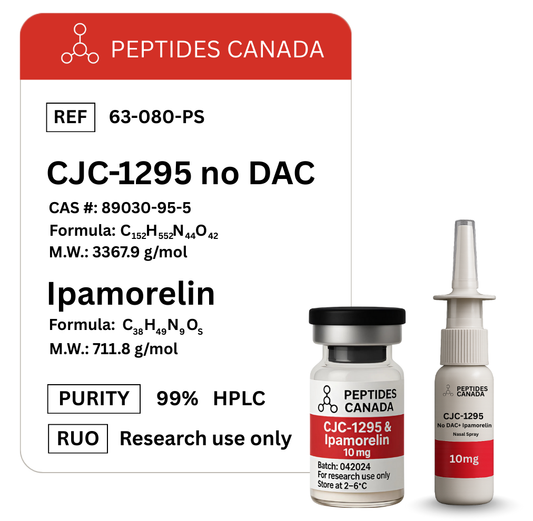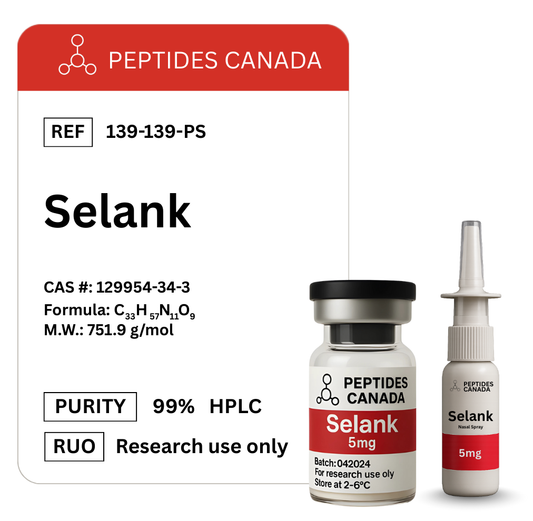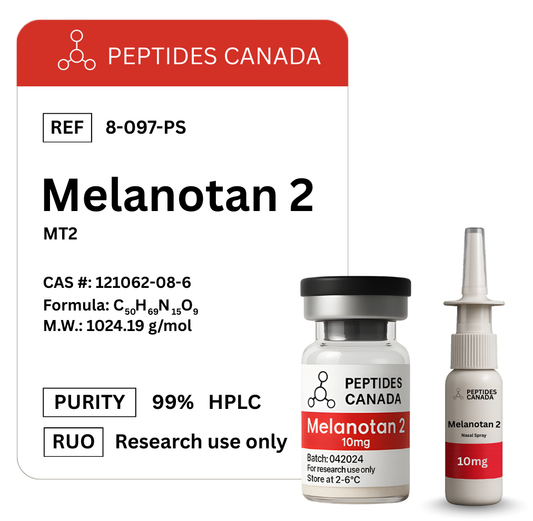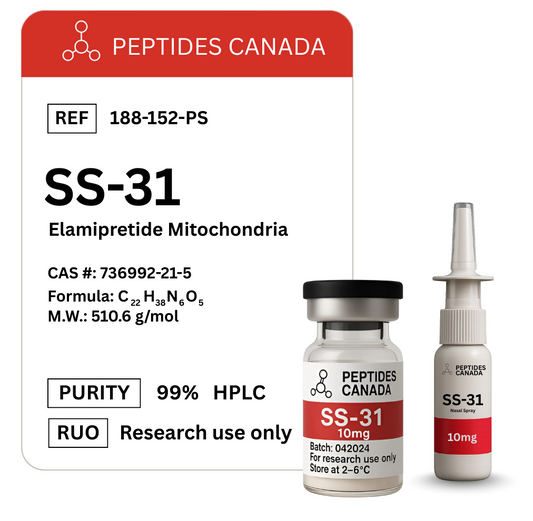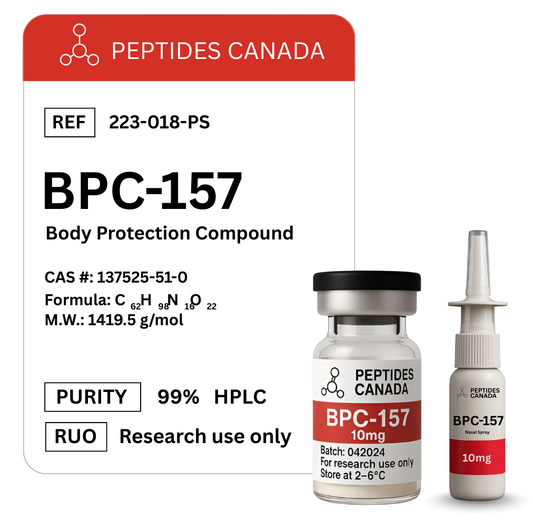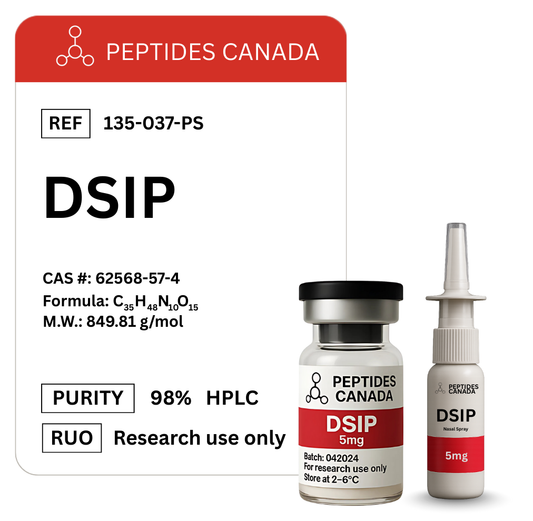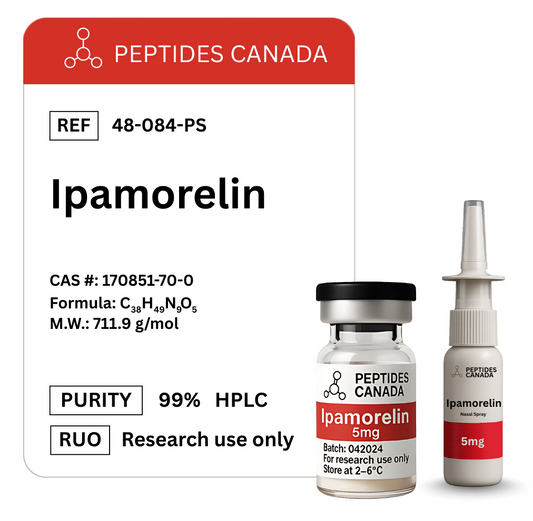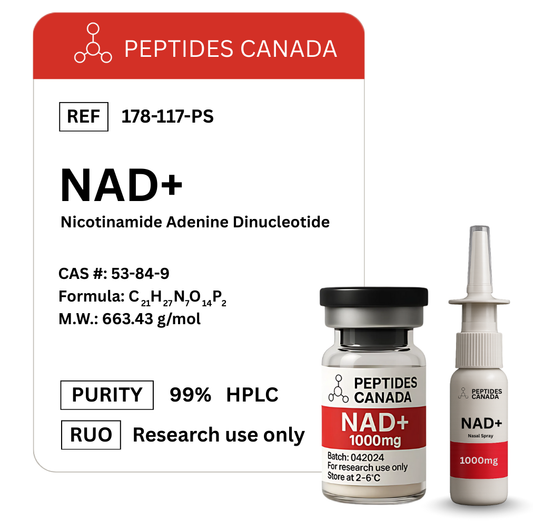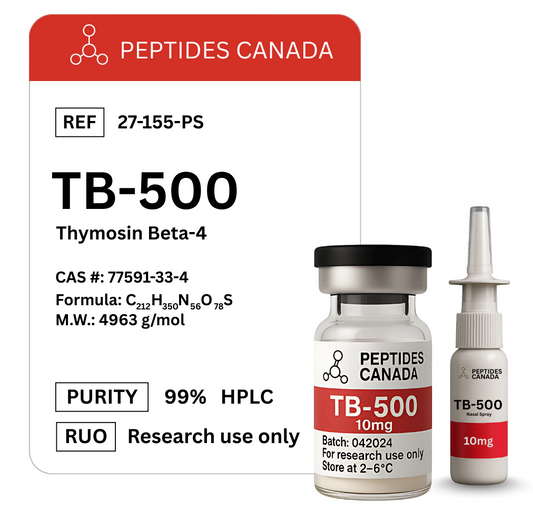KLOW Blend - GHK-CU + TB-500 + BPC-157 + KPV 10mg - Total 80mg. An advanced blend for skin, healing, and inflammation.
KLOW Blend - GHK-CU + TB-500 + BPC-157 + KPV 10mg - Total 80mg. An advanced blend for skin, healing, and inflammation.
This batch of GHK-CU + TB-500 + BPC-157 + KPV Peptide Blend has been third party lab tested and verified for quality.
Size: 80mg
Contents: GHK-Cu (Copper Tripeptide-1), TB-500 (Thymosin Beta-4 Fragment), BPC-157 (Body Protection Compound), and KPV (Lysine–Proline–Valine Tripeptide)
Form: Lyophilized Powder
Purity: 99.2%
Couldn't load pickup availability
 Free Reconstitution Solution automatically added to your cart with each order.
Free Reconstitution Solution automatically added to your cart with each order.
This product is Made, Tested & Shipped From Canada.
Ships Today
Order by 1:00 PM EST
Free Shipping
For 2 or more vials


Verified+






GHK-Cu + TB-500 + BPC-157 + KPV Peptide Blend
This multi-component peptide formulation combines four distinct research peptides—GHK-Cu, TB-500 (Thymosin β4 fragment 17-23), BPC-157, and KPV—each of which has been investigated for its potential to influence cellular repair, tissue remodeling, and inflammatory pathways. The combined blend provides a platform for advanced study of peptide-mediated regenerative and anti-inflammatory mechanisms in experimental biological models.
Overview
Peptide-based signaling plays a critical role in cellular repair and immune modulation. The individual components of this blend have been studied for complementary properties:
GHK-Cu (Copper Tripeptide-1)
GHK-Cu is a naturally occurring copper-binding tripeptide (glycyl-L-histidyl-L-lysine-Cu²⁺) present in human plasma and tissues. It has been reported to upregulate the synthesis of collagen, elastin, and glycosaminoglycans in cultured fibroblasts, while also modulating gene expression linked to tissue regeneration and antioxidant defense. Research indicates that GHK-Cu may also promote angiogenic activity and support wound closure models by influencing metalloproteinase balance.
TB-500 (Thymosin β4 Fragment 17-23)
TB-500 represents a synthetic segment of the Thymosin β4 molecule containing the actin-binding domain (Ac-Ser-Asp-Lys-Pro-Asp-Met-Ala-Glu-Ile-Glu-Lys-Phe-Asp-Lys-OH). In vitro and in vivo experiments have suggested roles in actin cytoskeleton organization, cellular migration, and differentiation. TB-500 has been studied in angiogenesis models, where it may enhance endothelial cell migration and capillary formation.
BPC-157 (Body Protection Compound-157)
BPC-157 is a stable pentadecapeptide fragment derived from a gastric protective protein. Experimental data suggest it modulates nitric-oxide signaling, fibroblast recruitment, and angiogenesis. Rodent studies have associated BPC-157 administration with accelerated wound closure, tendon and ligament regeneration, and gastrointestinal mucosal protection. These effects are believed to be mediated through the activation of growth factor receptors and modulation of the VEGF and FAK-paxillin pathways.
KPV (Lys-Pro-Val)
KPV is a short α-MSH (melanocortin)–derived tripeptide with recognized anti-inflammatory properties. Research indicates KPV can suppress the nuclear translocation of NF-κB and reduce the expression of pro-inflammatory cytokines such as TNF-α and IL-6 in cellular models. It is often utilized in experimental inflammation assays to explore melanocortin receptor signaling (particularly MC1R-mediated responses).
Chemical Makeup
- Total Blend Mass: 80 mg
- Constituents: GHK-Cu, TB-500, BPC-157, KPV (individual ratio proprietary; combined purity ≥ 98 % by HPLC)
Each peptide component is independently characterized by LC-MS to verify molecular identity and purity before formulation. The combined lyophilized blend is provided as a homogeneous powder suitable for reconstitution in sterile water for biochemical research applications.
Research and Experimental Studies
GHK-Cu and Cellular Regeneration
Research demonstrates that GHK-Cu can activate gene networks related to tissue remodeling, stem cell differentiation, and anti-oxidative responses. In dermal fibroblast cultures, GHK-Cu exposure increased collagen and decorin expression and reduced reactive oxygen species.
TB-500 and Cytoskeletal Dynamics
In wound-healing and myocardial injury models, TB-500 has been reported to improve cell migration and capillary tube formation. The fragment’s actin-binding motif enables the stabilization of G-actin monomers, facilitating cellular motility during regeneration.
BPC-157 and Angiogenic Modulation
Studies in tendon, muscle, and gastric tissue models indicate that BPC-157 supports angiogenesis and enhances fibroblast activity, potentially through upregulation of VEGF receptor-2 and nitric-oxide synthase. It has also been linked to reduced pro-inflammatory mediator release in experimental colitis and soft-tissue repair models.
KPV and Inflammatory Regulation
KPV has been shown to exert localized anti-inflammatory effects by downregulating NF-κB activation and cytokine expression in epithelial and macrophage cultures. Its use in experimental dermatologic and intestinal inflammation models continues to provide insight into melanocortin-based immune modulation.
Synergistic Research Potential
The combination of these four peptides offers a multi-pathway model for studying coordinated tissue repair and immune balance. Their distinct receptor targets and signaling pathways—copper-dependent enzymatic activation (GHK-Cu), actin polymerization control (TB-500), growth factor receptor modulation (BPC-157), and melanocortin receptor activity (KPV)—provide a complex but complementary biochemical network suitable for advanced regenerative biology research.
This peptide blend is supplied strictly for research and laboratory use only. Not for human or veterinary application.
References
- Pickart L, et al. The human tri-peptide GHK and tissue remodeling. J Biomater Sci Polym Ed. 2005;16(6):671-684. https://pubmed.ncbi.nlm.nih.gov/16046853/
- Maquart FX, et al. Stimulation of collagen synthesis by GHK-Cu. FEBS Lett. 1988;238(2):343-346. https://pubmed.ncbi.nlm.nih.gov/3166886/
- Sosne G, et al. Thymosin β4 and its synthetic analogs in cell migration. Ann N Y Acad Sci. 2007;1112:113-122. https://pubmed.ncbi.nlm.nih.gov/17947592/
- Smart N, et al. Thymosin β4 induces adult epicardial progenitor mobilization. Nature. 2007;445(7124):177-182. https://pubmed.ncbi.nlm.nih.gov/17215841/
- Chang CH, et al. Thymosin β4 promotes keratinocyte migration via integrin-linked kinase. J Invest Dermatol. 2010;130(3):658-666. https://pubmed.ncbi.nlm.nih.gov/19812597/
- Sikiric P, et al. The influence of BPC-157 on blood vessel and tissue healing. Curr Pharm Des. 2018;24(18):1974-1989. https://pubmed.ncbi.nlm.nih.gov/29708060/
- Brcic L, et al. BPC-157 modulates VEGFR2 and NO pathways in injured tendon. Muscles Ligaments Tendons J. 2015;5(4):289-298. https://pubmed.ncbi.nlm.nih.gov/26697586/
- Staresinic M, et al. BPC-157 accelerates wound healing in rat skin. J Physiol Pharmacol. 2003;54(3):365-377. https://pubmed.ncbi.nlm.nih.gov/14566078/
- Wikberg JE, et al. Melanocortin peptides and inflammation. Peptides. 2000;21(3):371-375. https://pubmed.ncbi.nlm.nih.gov/10822038/
Getting SJ, et al. Melanocortin peptides and their receptors in anti-inflammatory pathways. Br J Pharmacol. 2006;149(6):723-732. https://pubmed.ncbi.nlm.nih.gov/17031384/- Milos PM, et al. KPV tripeptide reduces cytokine-induced NF-κB activation. Inflamm Res. 2001;50(9):500-506. https://pubmed.ncbi.nlm.nih.gov/11605739/
- Pickart L, et al. Gene expression modulation by GHK-Cu. Bioinformatics Biol Insights. 2012;6:1-15. https://pubmed.ncbi.nlm.nih.gov/22399871/
- Hinkel R, et al. Thymosin β4 in cardiovascular regeneration. J Mol Med. 2008;86(7):723-735. https://pubmed.ncbi.nlm.nih.gov/18461361/
- ClinicalTrials.gov. Study of BPC-157 and wound healing. https://clinicaltrials.gov/ct2/show/NCT04173625
- National Center for Biotechnology Information. PubChem Summary for CID 16131225 (GHK-Cu). https://pubchem.ncbi.nlm.nih.gov/compound/16131225
For Research Use Only. Not for human or veterinary use.


-

HIGHEST QUALITY PEPTIDES
Our products are scientifically formulated and manufactured in cGMP-compliant facilities.
-

FAST DELIVERY
Enjoy fast and reliable 3–5 day shipping.
-

Dedicated Customer Service
Our customer service team is highly knowledgeable in peptide research and its applications. We’re available 24/7 to assist you.
Verified reviews
Tested. Verified. Trusted.
We take a laboratory-first approach to quality. Each batch is made under controlled conditions and verified by an independent lab (HPLC/MS). We only ship batches that test ≥99% purity, and we provide a full COA, including identity, methods, and chromatograms, for your review.
Shop now


See the Process for Yourself
We make our peptides in our own cGMP lab. Watch the video to see how every vial is produced, tested, and handled with care.

Science Behind Our Peptides
A clear explanation of how our peptides work, their benefits, why quality matters for best results, and what you should know.
You may also like
-
BPC-157 + TB-500 Peptide Blend - 20mg Total. Premier peptide for rapid healing of muscle, tendon, ligament, and gut injuries.
Regular price From $87.00Regular price From $87.00 Sale priceUnit price / per$114.0023% -
Retatrutide Triple Agonist - 20mg. Next-generation triple-agonist for aggressive fat loss and metabolic optimization.
Regular price From $90.00Regular price From $90.00 Sale priceUnit price / per$118.0023% -
CJC-1295 No DAC & Ipamorelin - 10mg (5mg each)
Regular price From $90.30Regular price From $90.30 Sale priceUnit price / per$118.0023% -
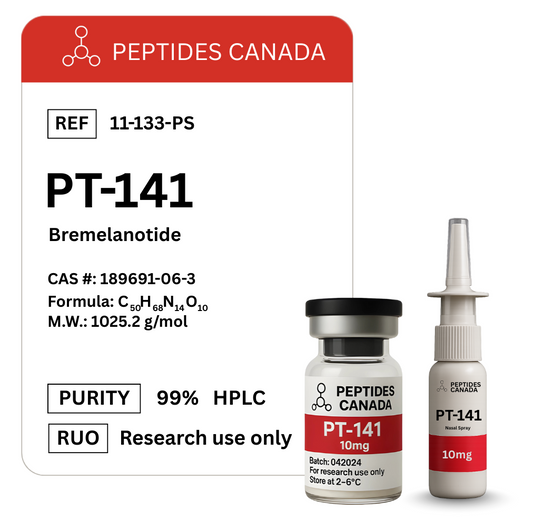 SAVE 23%
SAVE 23%PT-141 Peptide - 10mg
Regular price From $41.99Regular price From $41.99 Sale priceUnit price / per$55.0023% -
Selank Nootropic Peptide - 5mg. Combines cognitive enhancement with significant anti-anxiety effects.
Regular price From $22.00Regular price From $22.00 Sale priceUnit price / per$31.0029% -
Semax Nootropic. Powerful nootropic for intense focus and mental clarity.
Regular price From $40.00Regular price From $40.00 Sale priceUnit price / per$54.0025% -
Melanotan II (MT2) Peptide - 10mg. Stimulates melanin for a deep, protective tan with less sun exposure.
Regular price From $28.00Regular price From $28.00 Sale priceUnit price / per$38.0026% -
BPC-157 + TB-500 + GHK-Cu Peptide Blend - 70mg Total
Regular price From $139.00Regular price From $139.00 Sale priceUnit price / per$181.0023% -
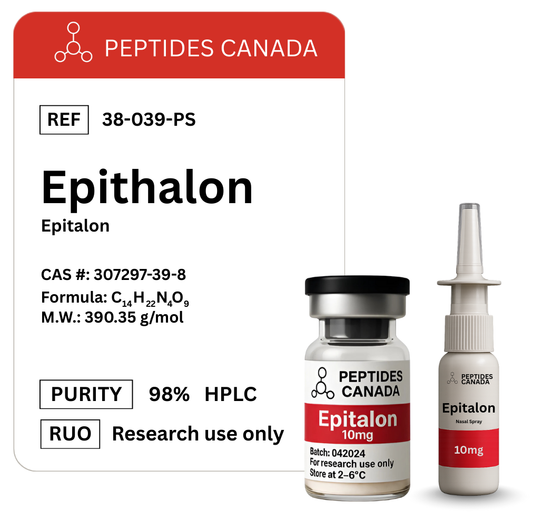
Epitalon (Epithalon) A longevity peptide studied for telomere support and deep sleep regulation.
Regular price From $28.00Regular price From $28.00 Sale priceUnit price / per$38.0026% -
GHK-Cu Copper Peptide - 50mg. Premier copper peptide for boosting collagen, tightening skin, and reducing scarring.
Regular price From $50.00Regular price From $50.00 Sale priceUnit price / per$67.0025% -
 SAVE 23%
SAVE 23%BAC Bacteriostatic Water
Regular price From $13.00Regular price From $13.00 Sale priceUnit price / per$17.0023% -
VIP (Vasoactive Intestinal Peptide) - 10mg. Neuro-regulator and anti-inflammatory agent important for gut health.
Regular price From $75.00Regular price From $75.00 Sale priceUnit price / per$98.0023% -
SS-31 (Elamipretide) Mitochondrial Peptide - 10mg
Regular price From $95.00Regular price From $95.00 Sale priceUnit price / per$127.0025% -
BPC-157 Body Protection Compound - 10mg. Premier peptide for rapid healing of muscle, tendon, ligament, and gut injuries.
Regular price From $38.00Regular price From $38.00 Sale priceUnit price / per$50.0024% -
DSIP (Delta Sleep-Inducing Peptide) (Delta Sleep-Inducing Peptide): Neuropeptide studied for promoting deep, restorative sleep.
Regular price From $24.00Regular price From $24.00 Sale priceUnit price / per$32.0025% -
Ipamorelin Growth Hormone Peptide - 5mg
Regular price From $27.00Regular price From $27.00 Sale priceUnit price / per$36.0025% -
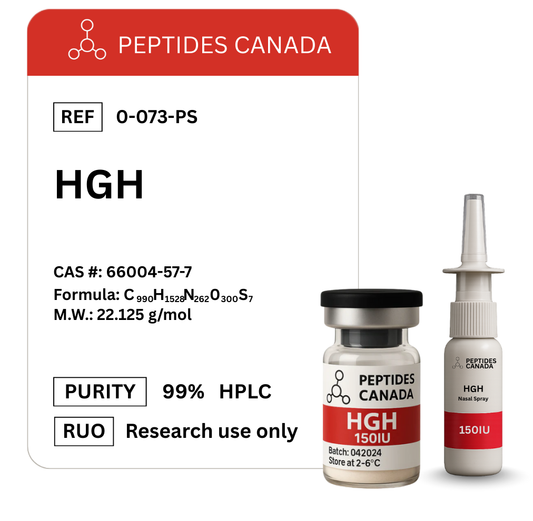 SAVE 23%
SAVE 23%HGH (Human Growth Hormone) - 150IU
Regular price $172.00Regular price $172.00 Sale priceUnit price / per$224.0023% -
NAD+ Crucial coenzyme for cellular energy, DNA repair, and anti-aging pathways.
Regular price From $38.00Regular price From $38.00 Sale priceUnit price / per$50.0024% -
KLOW Blend - GHK-CU + TB-500 + BPC-157 + KPV 10mg - Total 80mg. An advanced blend for skin, healing, and inflammation.
Regular price From $188.00Regular price From $188.00 Sale priceUnit price / per$246.0023% -

HGH 191AA (Somatropin) The foundational hormone for overall growth, recovery, and body composition.
Regular price From $50.00Regular price From $50.00 Sale priceUnit price / per$67.0025% -
Kisspeptin-10. Key peptide that initiates the body's hormonal cascade for reproduction.
Regular price From $63.00Regular price From $63.00 Sale priceUnit price / per$85.0025% -
TB-500 (Thymosin Beta-4) Peptide - 10mg. Systemic healing peptide that reduces inflammation and promotes recovery.
Regular price From $50.00Regular price From $50.00 Sale priceUnit price / per$68.0026% -
Pinealon: Peptide Bioregulator for supporting brain cell health.
Regular price From $50.00Regular price From $50.00 Sale priceUnit price / per$65.0023% -
PNC-27: Researched in an oncological context for targeting cancer cells.
Regular price From $176.00Regular price From $176.00 Sale priceUnit price / per$229.0023% -

Oxytocin Acetate 2mg. The "bonding hormone" which also plays a role in arousal and intimacy.
Regular price From $38.00Regular price From $38.00 Sale priceUnit price / per$52.0026% -
HGH Fragment 176-191 5mg. The specific HGH segment for targeted fat burning without other hormonal effects.
Regular price From $87.00Regular price From $87.00 Sale priceUnit price / per$114.0023% -
Glutathione 1500mg. The body's master antioxidant for brighter skin and detoxification.
Regular price From $75.00Regular price From $75.00 Sale priceUnit price / per$98.0023% -
 SAVE 25%
SAVE 25%Dermorphin 5mg
Regular price From $50.00Regular price From $50.00 Sale priceUnit price / per$67.0025% -
Melatonin 10mg. The primary hormone that regulates the sleep-wake cycle.
Regular price From $50.00Regular price From $50.00 Sale priceUnit price / per$67.0025% -

Follistatin 1mg. A myostatin inhibitor designed to unlock genetic potential for muscle growth.
Regular price From $150.00Regular price From $150.00 Sale priceUnit price / per$197.0023% -
GDF-8 1mg. The protein that inhibits muscle growth; for research purposes only.
Regular price From $125.00Regular price From $125.00 Sale priceUnit price / per$164.0023% -
Sermorelin 5mg. A foundational GHRH for restoring natural GH levels.
Regular price From $63.00Regular price From $63.00 Sale priceUnit price / per$84.0025% -
PEG MGF 2mg. A pegylated (longer-acting) version of MGF.
Regular price $100.00Regular price $100.00 Sale priceUnit price / per$132.0024% -
MGF 2mg. Ideal for post-workout muscle repair and localized growth.
Regular price From $38.00Regular price From $38.00 Sale priceUnit price / per$51.0025% -
 SAVE 23%
SAVE 23%ACE-031 1mg
Regular price From $113.00Regular price From $113.00 Sale priceUnit price / per$148.0023% -
 SAVE 24%
SAVE 24%Oxytocin 2mg
Regular price From $40.00Regular price From $40.00 Sale priceUnit price / per$53.0024% -
 SAVE 24%
SAVE 24%Triptorelin 2mg
Regular price From $40.00Regular price From $40.00 Sale priceUnit price / per$53.0024% -
 SAVE 25%
SAVE 25%Gonadorelin 2mg
Regular price $50.00Regular price $50.00 Sale priceUnit price / per$67.0025% -
 SAVE 23%
SAVE 23%SLU-PP-322 5mg
Regular price From $113.00Regular price From $113.00 Sale priceUnit price / per$148.0023% -
 SAVE 25%
SAVE 25%Tirzepatide
Regular price From $50.00Regular price From $50.00 Sale priceUnit price / per$67.0025% -
 SAVE 27%
SAVE 27%Semaglutide
Regular price From $32.00Regular price From $32.00 Sale priceUnit price / per$44.0027% -
Lemon Bottle 10mg. Cosmetic lipolysis (fat-dissolving) solution.
Regular price From $75.00Regular price From $75.00 Sale priceUnit price / per$98.0023% -
 SAVE 27%
SAVE 27%Acetic Acid Water 0.6%
Regular price From $13.00Regular price From $13.00 Sale priceUnit price / per$18.0027% -
 SAVE 23%
SAVE 23%Benzyl Alcohol 0.9%
Regular price From $13.00Regular price From $13.00 Sale priceUnit price / per$17.0023% -
 SAVE 23%
SAVE 23%Sterile Water
Regular price From $13.00Regular price From $13.00 Sale priceUnit price / per$17.0023% -
Glow BPC-157 + GHK-CU + TB-500 Peptide Blend 70mg Total 70mg. Focused on systemic healing and skin rejuvenation.
Regular price From $125.00Regular price From $125.00 Sale priceUnit price / per$164.0023%
Every vial we sell comes from a lab that follows current Good Manufacturing Practices (cGMP). That means each step of production is documented and controlled. Before a batch is released, it’s tested by independent third-party labs for purity, identity, and sterility. Certificates of analysis are available so you can see the exact test results.
Yes. The labs we work with use ISO-certified clean rooms where air quality, equipment, and handling procedures are tightly regulated. Staff are trained to pharmaceutical-grade standards. This ensures the peptides are produced in an environment that minimizes contamination risks.
Peptides in lyophilized (freeze-dried) form are stable at room temperature for transport. Once you receive them, refrigeration is recommended to maintain long-term integrity. We package every order securely to prevent damage and ship promptly, so your vials arrive in optimal condition.
We operate under strict in-house protocols that follow current Good Manufacturing Practices (cGMP). That means our team oversees the entire process from sourcing raw amino acids to the final lyophilized vial. Nothing is outsourced or repackaged. This gives us full control over purity, consistency, and sterility, and it’s why we can stand behind every single vial we ship.
Store them in the refrigerator, away from direct light and heat. If you need to keep them longer, some peptides can be stored frozen. Each vial comes with clear handling instructions so you know the proper conditions for stability.
The strongest proof is transparency. For every peptide, we can provide certificates of analysis, manufacturing documentation, and references to the published scientific research behind it. If you ever have questions, we’ll show you the data rather than ask you to take our word for it.
The difference is transparency. Most sites give you a product name and a price. We provide full batch testing, lab documentation, and direct access to certificates of analysis so you don’t have to guess what you’re getting. When you order from us, you know exactly what’s in the vial, where it was made, and how it was verified.













